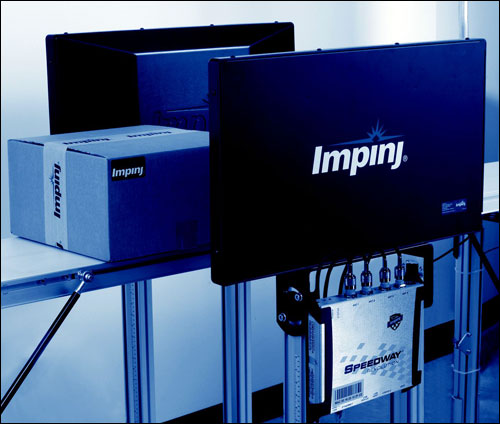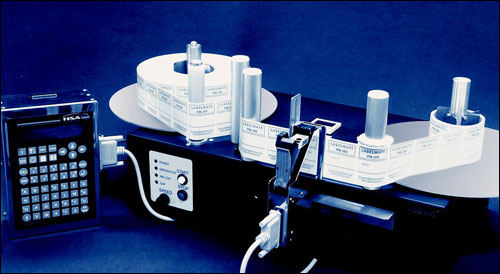With an eye toward boosting speed for writing data to item-level EPC Gen 2 ultrahigh-frequency (UHF) tags, as well as reducing the incidence of encoding errors, Impinj is releasing two new products: the Monza 5 chip and the STP Source Tagging platform, which combines previously released Impinj readers and antennas with new firmware dedicated to encoding tags at high speed. In anticipation of the expected ramp-up of RFID tagging of apparel in the retail market, the products are intended to aid goods manufacturers, as well as service bureaus that supply tags to those manufacturers, by making the writing process faster, with fewer encoding errors. Impinj predicts that for product manufacturers to be able to tag goods at the item level without slowing down their own processes, RFID technology will need to become faster and more accurate than what is currently possible using existing systems, to allow the encoding of large quantities of tags without errors.
The Monza 5 chip is designed to support an encoding rate of up to 3,000 tags per minute, and comes with a 48-bit serialized tag identifier (TID) memory. With Impinj’s FastID inventory mode—intended to boost the speed of TID authentication by reading the 48-bit TID concurrently with the writing of an EPC number, rather than reading the TID first and then encoding the EPC as a second step—the Monza 5 can boost encoding speeds by up to 220 percent compared with other RFID technology on the market. While Impinj’s Monza 4 supports dual tag antennas (designed for item-level RFID applications, such as tagging luggage), the Monza 5 supports a single antenna. A tag manufactured with a Monza 5 chip, however, is four to six times more sensitive for encoding, and about 25 percent more sensitive for reading, than tags made with other chips currently available, says Scot Stelter, Impinj’s senior director of product marketing. By increasing sensitivity, he explains, the company is able to provide a chip that is encoded faster, with less likelihood of failing. This greater sensitivity and speed for encoding, he says, is accomplished using several features.

The chip’s SafeWrite mechanism is intended to reduce the rate of failed encodings. With SafeWrite, a circuit in the chip monitors the amount of power in that chip, and does not allow encoding until it determines that the power is at a high enough level. If a tag with insufficient power is encoded, Stelter explains, it could then fail to be encoded properly, and would thus be rendered unreadable.
The Monza 5 chip also comes with a feature known as TagFocus, intended to minimize redundant reads within a crowded reading environment (many tags passing through a portal at once). Stelter likens an item-level tag-reading environment to a classroom filled with noisy children, noting that those tags that might be in the front row and are the noisiest (such as those closest to the reader, with no obstructions) tend to interfere with other reads from tags further away. With TagFocus, the tags already read can be “parked” so that they will cease transmitting once read, and then remain silent until the read event is completed.
While other EPC tags can also be parked, Stelter says, those other tags resume transmitting within a short span of time—approximately half a second—while tags made with the Monza 5 chip remains parked as long as the reader is transmitting. With Monza 5, the interrogator can extend the time that tags are kept quiet after first being read during an inventory, from the typical half-second to an indefinite period.
Impinj is currently working with multiple RFID inlay manufacturers that will use the chip in their tags, Stelter says, including Avery Dennison, Invengo, Smartrac and UPM RFID.
Impinj has not yet indicated the chip’s cost. However, Stelter says, “Monza 5 is competitively priced for the single-antenna item-tagging market.”

“Even in an in-store environment, the numbers of items being tagged is going to increase,” says Michael Liard, ABI Research‘s practice director for RFID, so the release of a lower cost, high-speed chip will prove to be an advantage to the retail market.
The STP Source Tagging platform is a reader and firmware combination designed for encoding large quantities of RFID tags, either in bulk (already attached to garments and packed in cartons, then transported through an RFID portal) or in-line (in a single-file format, encoding each label in quick succession on a roll before applying them to clothing). While most readers are optimized specifically for reading, says Bill McBeath, the chief research officer at supply chain management analyst firm ChainLink Research, “this platform is designed for encoding.” It operates with tags manufactured with Impinj ICs, as well as those made with other companies’ EPC Gen 2 UHF chips.
The STP platform includes Impinj’s existing Speedway Revolution 4-port reader and Guardwall, Mini-Guardrail and MatchBox antennas, designed for high-speed encoding of closely spaced tags. If a tag fails to be encoded, that error is captured in the STP firmware, rather than in the software (as is the case with traditional systems), the latter of which requires more time to identify a mistake and then attempt to rewrite. The STP platform includes either near-field or transition-field antennas optimized for in-line or bulk encoding, respectively, and designed to deliver a greater amount of RF energy to the tags.
With an inline system, the antennas are designed to provide high-speed encoding of tags one at a time as they pass by. “We have two models [the Mini-Guardrail and the MatchBox] that enable the reader to individually address one tag at a time, on a roll of closely spaced, on-pitch tags,” Stelter states. These antennas, usually mounted millimeters away from the tags, employ near-field methods to severely limit each antenna’s range and field of view.
For bulk-encoding, Impinj provides a pair of its Guardwalls—large antennas, comparable in size to a 28-inch-by-16-inch corrugate case. The antennas are mounted on opposite sides of the conveyor line. “They create an intense, but confined field that focuses energy on the contents of the case while reducing the potential for stray reads,” Stelter says. “This, in combination with the high sensitivity of the tag chips, helps penetrate to the center of the case so that the reader can inventory, singulate and then encode the tags with fewer retries.”
The STP system is capable of encoding in-line at 1,750 tags per minute, and encoding in bulk at 1,100 tags per minute.
Service bureaus that use the in-line system could benefit from the increased speed and encoding-error reduction, Stelter says. However, he notes, the biggest gains might be for goods manufacturers or distributors that bulk-encode tags after they’ve been applied to garments and loaded into cartons. In such a situation, as the boxes are moved through portals, tags affixed to multiple items packed within those cartons, all of the same stock-keeping unit (SKU), could be encoded automatically. Although such bulk-encoding is already being accomplished with existing technology, McBeath says, the use of the STP platform would potentially result in significant cost-savings by reducing the error rate, since each mistake typically requires that a carton be opened and the failed tag be located. There are two versions of the STP firmware: one designed to work only with Monza-based inlays, which is free to customers, and another that is compatible with all UHF Gen 2 chips, which carries a one-time $7,500 licensing fee, not including the cost of hardware.
By the fourth quarter of this year, Stelter says, Impinj plans to release a new version of the STP platform that will allow the encoding of mixed SKUs, such as multiple types of apparel, within a single case. The system will be able to read the TID, recognize the associated SKU of the product to which that tag is attached (to achieve this, the TID would be previously stored in a database and be associated with a product’s particular SKU type at the time of that product’s manufacture) and proceed to encode the EPC number to link to that tagged item.
By offering faster encoding technology to address the needs of goods manufacturers and service bureaus, McBeath says, “I think Impinj has a pretty well-reasoned strategy. Source tagging is becoming more and more important in the retail market, and the [RFID vendors’] focus has been on [improving] read-performance rather than write-performance issues.” Making tags faster to encode, he says, will enable large manufacturers to continue their processes without slowing them down, or adding steps to ensure the tags are properly encoded.
Over time, Stelter says, Impinj expects the Monza 5 to displace its Monza 3 chip. “Monza 3 has been the number-one selling UHF RFID tag chip in the world,” he notes, “and it has been designed into many high-volume applications, so we will support our user base by shipping Monza 3 at least into 2012, while our customers migrate to Monza 5. We think that the higher sensitivity, faster encoding performance and other features are enough motivation for most users to make the switch in 2011.”


